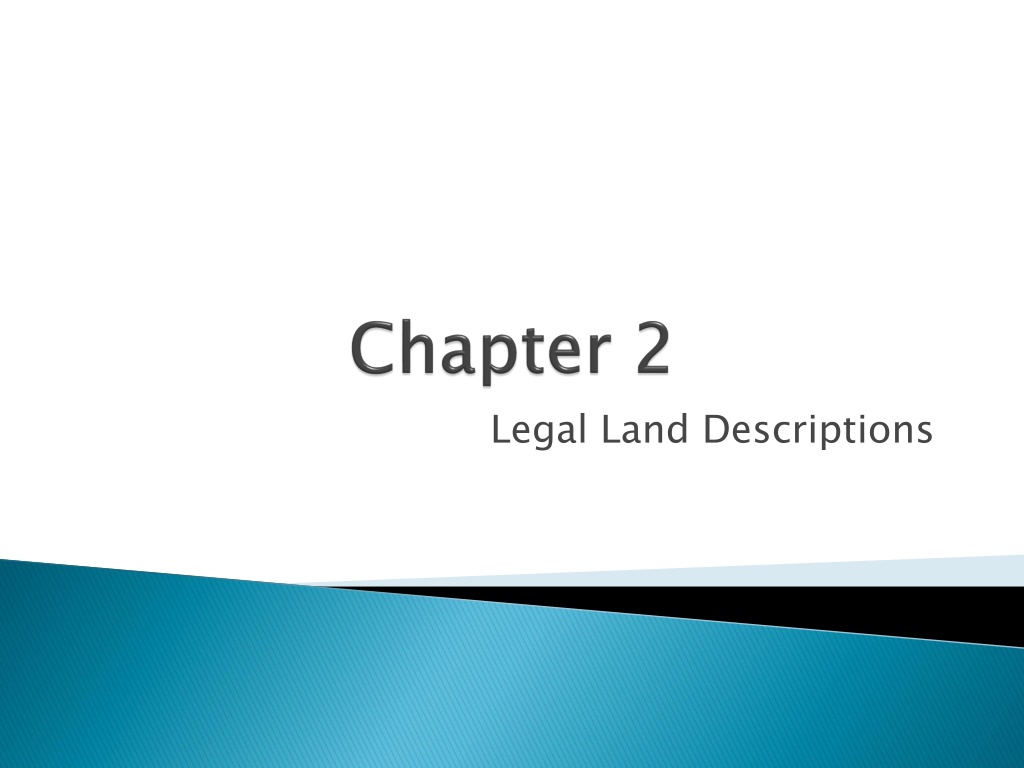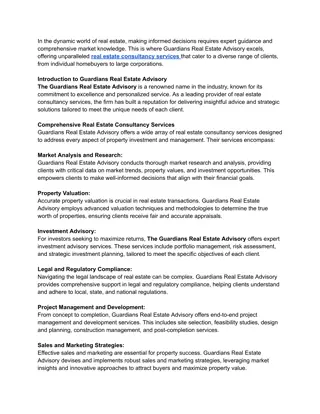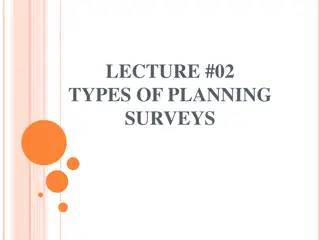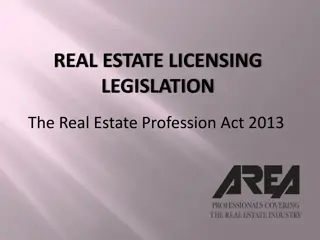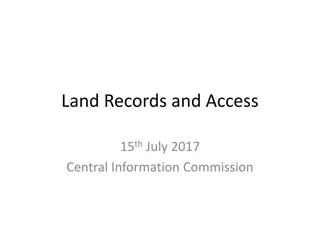Understanding Land Descriptions and Surveys in Real Estate
Explore the intricate world of legal land descriptions, including counties, townships, concessions, and lots. Learn about the different types of townships and how surveys are crucial in measuring land accurately. Discover the significance of chains, acreage, and the role of Ontario Land Surveyors in preparing surveys governed by legislation.
Download Presentation

Please find below an Image/Link to download the presentation.
The content on the website is provided AS IS for your information and personal use only. It may not be sold, licensed, or shared on other websites without obtaining consent from the author. Download presentation by click this link. If you encounter any issues during the download, it is possible that the publisher has removed the file from their server.
E N D
Presentation Transcript
There are four types of land descriptions: 1. Counties (regions) Examples include Peel Region, Durham Region and York Region 2. Townships (cities) Each region has a number of townships Examples of townships in Peel Region include Oakville, Brampton and Mississauga 3. Concessions (area between major roads) Examples include Markham Road to Kennedy Road; Kennedy Road to Warden 4. Lots Each concession is divided into a number of lots
Lots and concessions do not have names but townships and counties do If you go to a new subdivision, you will see that new houses are marked by their concession and lot numbers e.g. concession 130, lot 45, not house numbers Concessions are strips of land that together make up a township. They are separated by road allowances Lots are situated within concessions
Roads divide 2 concessions Roads are township road allowance
There are three types of townships 1. Single-front (oldest type of township) 2. Double-front 3. Sectional Townships used to be measured with chains Iron chains were used because they do not expand Each chain was 66 feet long and has 100 links 80 chains made one mile A Single Front Township has 200 acres per lot (20 chains x 100 chains = 200 acres)
A Double Front Township has 100 acres per half lot A Sectional Township has 1000 Acre sections, each with 10 lots (these lots are called subsequent divisions)
Single-Front Township is the oldest type of township A township which is made up of 1000 acres for each set of 10 lots is called a Sectional Township Each chain has 100 links, and is 66 feet in length
Surveys are prepared by the Ontario Land Surveyor Surveys show measurements of land as well as any improvements made on the land, including pools, decks and structures Surveys are regulated by the Surveyor s Act, which is a piece of legislation (law)
The Surveyors Act has four parts: 1. Interpretation This lays down definitions pertaining to surveys 2. Field Survey Standards Sets accepted definitions for members of Association of Ontario Land Surveyors Lays down survey standards, minimum guidelines and practice parameters 3. Plans States how surveyor must make drawings, including specific practice requirements
4. Surveyors Real Property Report This sets the requirements of the report, including all components that it should be made up of The Surveyors Real Property Report is the final paper issued by the surveyor It must be completed in accordance with the standards set by the Ontario Land Surveyors Association Each property usually has its own report
The report consists of: 1. This should identify boundaries and structures on land Resembles content and format of reference plans, except: 1. This report may not be deposited as a separate document with the title in a land registration office whereas a reference plan can 2. A survey typically describes one specific property whereas a reference plan describes multiple properties 2. Written report A written report consists of: 1. Municipal address and information about land title and registry office designations 2. Bearings/dimensions of land boundaries as determined by a field survey Plan of survey (drawing)
3. Designation of all properties or lands or roads that are situated next to the property 4. Description, including location, of any relevant improvements on the property, as well as setbacks to property boundaries. Projections of eaves and overhangs, fences, pools, trees and walkways are also recorded 5. Location of right-of-ways or easements that are contained in the property 6. Location, description and dimension of visible encroachments on the property, including telephone cables 7. Location of survey monuments, both found and placed 8. Note indicating the party for whom the plan has been prepared 9. Certification by an Ontario Land Surveyor which may read: This document will be certified by _____________
A survey consists of four parts (RMMP) which each surveyor must undertake: 1. Research 2. Measurement 3. Monumentation These are markings placed on key points along the surface of Earth (e.g. orange marks on road) In case of natural hurdles (rivers, mountains), you must go through them, not around them 4. Real Property Report / Surveyor s Plan This has two parts: 1. 2. Survey/Plan of Survey Certification
What is the second step in the Real Property Report that results from a survey? Certification If you do not see certification, a written report
There are four main types of surveys: 1. Plan of Survey Not registered/ deposited at Land Registry Office Describes 1 property, unlike Reference Plan Does not meet requirements for registration under Registry Act and Titles Act 2. Subdivision Plan / Plan of Subdivision This is a plan which is registered at Land Registry Office once approved Meets requirements necessary for registration Displays boundaries where parks, buildings and streets are to be located
3. Surveyors Real Property Report Commonly known as Building Location Survey Shows boundaries of property and location of building Made up of Plan of Survey (see previous slide) and written report 4. Reference Plan (R-Plan) Graphic illustration deposited at Land Registration Office but not registered Most changes to land (subdivision/severance etc.) must be accompanied by R-Plan submission Blueprint used to illustrate proposed changes in land R-plans describe a number of properties (1,2,3,4 )
R-plans show surveyed boundaries, dimensions as well as documentary or physical evidence that could have an impact on title of the property It might show location of fences since these may suggest the existence of encroachments, easements etc. R-plans are typically required for severance of a plot or parcel since it serves a descriptive purpose R-plans may also be used to get permission for subdivision plans E.g. We submit this R-plan to the Land Registration Office to get permission for our proposed subdivision.
An official plan is a plan that lays out how a city will progress It is a planning document or a formal projection that must be approved by the Ministry of Municipal Affairs and Housing in accordance with the Planning Act An official plan contains goals, objectives and policies The city of Toronto has an official plan, which only becomes official when approved by the Ministry of Municipal Affairs and Housing
It is like an entire provinces Official Plan This statement is issued by Ministry of Municipal Affairs and Housing Deals with land planning throughout Ontario All Official Plans must be in accordance with the Provincial Policy Statement
A provincial policy statement deals with: 1. Long-term planning related to renewable sources of energy including wind and solar power 2. Minimizing urban sprawl by promoting efficient land use; supporting intensification in areas 3. Supporting protection of Ontario s environment through policies like protecting water resources 4. Encouraging protection of Ontario s natural heritage resources (e.g. wetlands and habitats) 5. Promoting the development of affordable housing 6. Responding to concerns over loss of farmland through prohibition of retirement lots 7. Supporting and protecting Ontario s rural areas by allowing rural-friendly development
Dividing land into 4 Or More Lots is called Subdivision You must fill a land development application (draft application) You will need a Subdivision Plan/Plan of Subdivision created as per the Planning Act This plan must be created by an Ontario Land Surveyor (i.e. a surveyor certified by the Ontario Government) This survey shows lots, blocks of land, road allowances in great detail It should also include the proposed structure
The application must be sent to the Upper Tier Government (e.g. Ontario or York region) Municipal Government (e.g. Town of Markham) is responsible for giving final approval of the plan Approval authority of municipal government sends notice of the draft plan to a number of agencies including utility companies, federal parks commission, Niagara escarpment commission etc.
If approved, the authority forwards all documents to the Ministry of Municipal Affairs and Housing at the provincial level The final step is to register the plan with the Land Registry Office The registry used to issue an M-Number but no longer does so Subdivisions are only created when you make more than 4 lots
The Subdivision Plan is created by an Ontario Land Surveyor, who is someone certified by the Ontario provincial government Subdivisions are only created when you create more than 4 lots The provincial government (Ministry of Municipal Affairs and Housing) gives final approval of the Subdivision Plan The Subdivision Plan gives land a geographic identity
Creating less than 3 lots is severance and not subdivision Severance is defined as dividing land into 3 or less parcels Land is divided as per the Planning Act
You must obtain permission to sever land from Committee of Adjustments (which operates at municipal level) It has the authority to grant severance as well as minor variances such as extending a deck or driveway Appeals against refusal to sever by Committee of Adjustments lies at provincial level with the Ontario Municipal Board (OMB) OMB deals with appeals, land use planning under the Planning Act and financial issues related to expropriation and Development charges
The Land Division Committee at municipal level is tasked with ultimately severing land It typically grants permission with conditions attached These conditions must be met before the permission expires, or else permission is revoked and it does not sever the land
A reference plan is for more than 1 property, lot or land A Surveyor s Real Property Report is for only 1 property or lot The reference plan is useful for avoiding the lengthy and confusing Metes and Bounds process
400 Series Highways are frequently known as Royal Highways or King s Highways
GIS combines the best of mapping with tables that outline details ranging from land developments to road systems to environmentally sensitive areas within a selected location It derives data from 3 sources: 1. Spatial data It maps data such as geographical features, including streets and buildings
2. Tabular data It provides quantified information that adds to mapping feature, such as building permits issued in the selected locale 3. Image data It gives visual images, including aerial photographs and images captured using satellites
